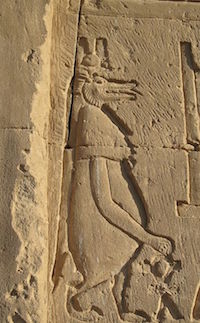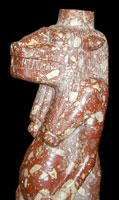
Taweret (Tawret, Taueret, Tawaret, Taurt, Thoeris and Toeris, Ipy, Ipet, Apet, Opet, Reret) was an ancient Egyptian patron of childbirth and a protector of women and children. Like Bes, she was considered to be a ferocious demon as well as a protective and nurturing deity. She was associated with the lion, the crocodile, and the hippo; all animals that were feared by the Egyptians but also highly respected.
Initially, she was viewed as a dangerous and potentially malignant force. Taweret was associated with the northern sky as Nebetakhet, the “Mistress of the Horizon”. She represented the circumpolar stars of Ursa Minor and Draco (the little dipper formed her back) who guarded the northern sky. The northern sky was thought to be cold, dark and potentially dangerous and was associated with both Apep and Set. According to one ancient myth, her husband Apep could only come out during the night and so she represented all that was evil during the day.
By the Old Kingdom she was seen as a protective, rather than an aggressive force (just as female hippos came to be seen as aggressive largely in defence of their young). As a result, Taweret became a mother goddess and a patron of childbirth who was often described as the mother or wet nurse of the pharaoh. As time passed she soon became a household deity, helping rich and poor alike.

When acting as a protective force Taweret is described as a goddess. She was thought to help women in labor and to ward off evil spirits and demons who intended harm to mother or baby. She was also thought to help with matters of female sexuality and pregnancy, and so she was often associated with the goddess Hathor.
As a fertility goddess Taweret was also associated with the inundation, particularly at Gebel el-Silsila. According to “The Book of the Dead”, Taweret guarded the paths to the mountains of the west which led to the underworld and could also use magic to help the deceased pass safely through that dangerous and frightening land.

Expectant mothers often carried amulets depicting Taweret to invoke her protection. These amulets remained popular even when Akhenaten moved his capital to Akhetaten and rejected the old gods in favour of The Aten. Her image also makes an appearance on cosmetic applicators, jewelry, headrests, and vessels. The vessels often had an opening in one of her nipples to allow the contents to be poured out and to add the protection of the goddess to the contents.
Taweret was associated with the so called “magic wand” or “magic knives” used during labour to ward off evil. These magical tools were usually made of hippopotamus ivory, and included depictions of the goddess.

Her family relationships were typically confusing. She was ocassionally (usually in older texts) described as the demon-wife of Apep who lived in the northern sky. This area was also associated with Set. One myth (reported by Plutarch) claimed that Taweret was the concubine of Set but that she was loyal to Horus. Apparently, she helped Isis after the death of her husband Osiris by detaining Set in the northern sky and preventing him from attacking Isis and her new baby. The link to Set probably came about because he sometimes took the form of a Hippo and because the animal was recognised to be potentially dangerous and destructive.
As the wife of Set she was linked to Isis whose magic kept the god in fetters. However, Taweret was also described as the wife of Sobek, probably because he took the form of a crocodile. Sobek was associated with Set, but also with Horus (the enemy of Set) and Isis. She was frequently described as the wife of Bes, a demonic deity who was also closely linked to childbirth. Finally, in Thebes, Amun and Taweret were thought to be the parents of Osiris (and therefore by implication his siblings, including Set).
One of the most popular festivals (called Ipet or Opet) celebrated her marriage to Amun thereby associating her with Amanuet and Mut. In fact in later times, Mut absorbed many of Taweret’s attributes. She was also associated with Nut the sky goddess of the Ennead because her constellation was always above the horizon.
Taweret was depicted as the combination of a crocodile, a hippo and a lion. However, unlike the composite demon Ammit she had the paws of a lion, the back of a crocodile, and the head and body of a pregnant hippo but with the addition of a woman’s hair. She often wears a short cylindrical headdress topped by two plumes or the horns and solar disk of Hathor, bearing the “Sa” (representing protection) or the ankh (representing life).
Sometimes Taweret was depicted with a crocodile on her back, thought to represent Sobek. Taweret literally means “The Great Female”, but she was also known as “Ipet” (“harem”) and “Reret” (“the sow”). At one point in history there may have been three variants of the goddess, but soon all were merged as Taweret.
Bibliography
- Bard, Kathryn (2008) An introduction to the Archaeology of Ancient Egypt
- Budge, E Wallis (1904) The Gods of the Egyptians
- Pinch, Geraldine (2002) Handbook Egyptian Mythology
- Redford Donald B (2002) Ancient Gods Speak
- Watterson, Barbara (1996) Gods of Ancient Egypt
- Wilkinson, Richard H. (2003) The Complete Gods and Goddesses of Ancient Egypt
Copyright J Hill 2016